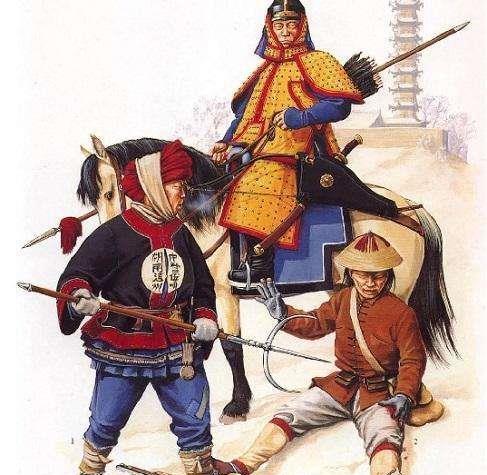In fact, looking at the portraits of the warriors of the Qing Dynasty, the more the waist knife of the Eight Banner Soldiers is anti-wear, that is, the sword handle rushes after the sheath of the sword rushes forward.
However, this habit declined more and more the more it went on, and after Jiaqing, it eventually became the sabre method before the handle and the sheath behind.
Therefore, "anti-Pei" is obviously the Manchu previous sabre tradition, and this sabre method has a specific name, called "Taiping Waist Knife" (but this is what is said in the commentary, there is no canonical history). This was the exclusive sabre method of the early Eight Flags cavalry.

The biggest advantage of this sabre method is that it is convenient for cavalry to use the knife.
When charging, the handle of the knife is not easy to fall off backwards and hurt the war horse. And it is more convenient to lean over the horse to draw the knife, which is less than the tactical action of flipping the wrist and rushing the tip of the knife forward than pulling the knife.
Therefore, the reason why the cavalry of the Eight Banners dominated the seventeenth century was that the waist knife alone was anti-wear, and when it was in contact with the enemy cavalry, there was one less tactical action, and his own knife could first cut the opponent and occupy the initiative of the battlefield.
Therefore, after the Eight Banner Soldiers entered the customs, they brought this sabre method to the palace, and almost all the guards in the palace in the early days were also this anti-saber habit.
However, the positive sabre was originally the traditional sabre method of infantry, and the Central Plains infantry came to the conclusion for thousands of years.
Because if the infantry is anti-sabre, it is more dangerous, and if the enemy appears behind him, it is a knife. The infantry did not have a rapid impact action, the waist knife did not worry about the knife falling, and the positive belt knife could always hold the handle of the knife and grasp the control of the waist knife.
Therefore, the method of anti-sabre is not suitable for infantry at all, and the pro-soldier guards in the court of the early Qing Dynasty, anti-sabre for nearly a hundred years, have not found anything wrong with this anti-sabre method?
The reason was that there was no short-term encounter at all, until a major event occurred during the Jiaqing period, causing the guards to reflect on how dangerous it was for the infantry to reverse the sabre.
In the 18th year of Jiaqing, the Tianli Sect rushed into the palace, and the guards found that they could not even draw the sabre in a hurry, not only did the original simple tactical action not play a role, but also had one more tactical action, that is, to take off the sabre, then turn the handle of the sword, and pull out the waist knife. It was two tactical movements slower than the enemy, and completely lost its battlefield initiative.
This time, the Tianli Sect broke into the palace, and finally after the emperor's second son Mianning (that is, the later Daoguang Emperor) killed two Tianli sect members with a shotgun, the Zhenguo Gong Yihao sent the firearm battalion and the Jianrui battalion into the palace to suppress it.
So later, basically the infantry anti-sabre situation disappeared almost gradually, but the military generals and cavalry were still accustomed to anti-sabre.
Original debut, welcome to pay attention or spit